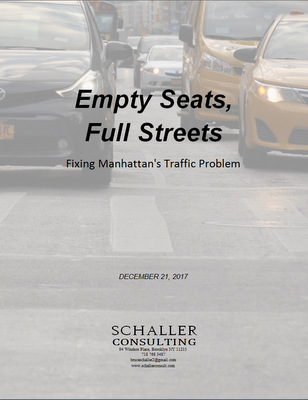| |
EMPTY SEATS, FULL STREETS
Fixing Manhattan's Traffic Problem
 Full report: Empty Seats, Full Streets: Fixing Manhattan's
Traffic Problem (pdf file)
Full report: Empty Seats, Full Streets: Fixing Manhattan's
Traffic Problem (pdf file)
The rapid growth of app-based ride services such as Uber, Lyft and Via, also called Transportation Network Companies (TNCs)
raises the question of how anti-congestion plans being developed by Governor Andrew Cuomo and Mayor Bill de Blasio
should address the impact of TNC trips on traffic congestion, particularly in the most congested areas of Manhattan.
Using newly available data on TNC trips, this report examines the impact of TNC growth on Manhattan traffic conditions.
Findings indicate that TNC growth has generated large increases in the number of TNC vehicles in the Manhattan Central Business District (CBD)
between 2013 and 2017.
Highlights:
- Taking into account the decline in yellow cab trips, the combined number of taxi/TNC vehicles on weekdays in the CBD
increased by 59 percent between 2013 and 2017.
- In the afternoon peak from 4 p.m. to 6 p.m., there are over 10,000 taxi/TNC vehicles in the CBD, more than double the number in 2013.
- One-third of the vehicles are empty, meaning between the drop-off of one passenger and
pick-up of the next passenger, clogging the streets without any mobility benefit to anyone.
This rapid growth is the product of several factors: increased number of trips, a trend toward longer trips (in distance),
slower traffic speeds, and drivers spending more time between fare-paying trips.
"Unoccupied" time between passengers experienced the most
rapid increases, up 81 percent over the last four years. These increases are of particular note since the increased time and mileage that drivers
spend between trips exacerbates Manhattan congestion without contributing to the mobility needs of New Yorkers.
The report focuses on ways to reduce unoccupied time in the CBD by taxis and TNCs as a promising traffic mitigation strategy. The report estimates that
overall traffic could be reduced by 7 percent to 11 percent from eliminating unnecessary unoccupied time between trips.
These reductions are on par with traffic improvements projected for the 2008 Bloomberg Administration
congestion pricing proposal.
The report calls for including reductions in TNC and yellow cab unoccupied time between trips, along with a per-trip fee paid by TNC and taxi
passengers, as part of a new congestion pricing proposal. A program along these lines would come close to reversing the
23 percent decline in Manhattan traffic speeds since 2010 and would produce substantial revenue for mass transit and other transportation improvements.
This recommendation was included in Gov. Andrew Cuomo's Fix NYC advisory panel's report in January 2018, which also recommended State Legislative adoption of congestion
pricing in the Manhattan business district and a surcharge on taxi and for-hire trips in Manhattan.
The report also discusses implications of this research for other cities. Although New York City presents unique circumstances
compared with other large U.S. cities, there are clear lessons to be gained from the New York experience. Chief among these is the
importance of the driver-driven nature of the supply of TNC service in which overall service hours are a product of decisions made by
individual TNC driver about where and when to work and how many hours to drive. The dynamics underlying a driver-driven supply of service is likely
to lead to excessive time spent between trips in cities across the country.
These findings also have significant implications for how the addition of shared autonomous vehicles to TNC fleets is likely
to affect traffic conditions in major cities. It is anticipated that autonomous vehicles will be operated in mixed fleets of shared
vehicles composed of both autonomous vehicles and human-driven vehicles. In the absence of policy intervention, expanding mixed fleets will further balloon the number of vacant vehicles, occupied only by drivers waiting for their next trip request. The results in this report thus heighten concerns about traffic impacts from the arrival of autonomous vehicles, underscoring the need for public policy to address traffic impacts of both today's TNCs and tomorrow's fleets of mixed human driven and autonomously driven ride services.
Full report: Empty Seats, Full Streets: Fixing Manhattan's
Traffic Problem (pdf file)
Press coverage
- New York Times: Your Uber Car Creates Congestion. Should You Pay a Fee to Ride?
- CityLab: How to Fix New York City's 'Unsustainable' Traffic Woes
- Streetsblog: Schaller: Curbing Uber “Idle Time” Key to Busting Manhattan Gridlock
|
